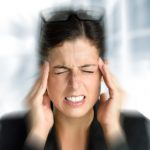 Migraine headaches may double the risk of Bell’s palsy (facial paralysis). Bell’s palsy is a condition categorized by a sudden weakness in facial muscles. This muscle weakness can cause half of your face to droop and make your smile look one-sided or as if one eye is nearly closed.
Migraine headaches may double the risk of Bell’s palsy (facial paralysis). Bell’s palsy is a condition categorized by a sudden weakness in facial muscles. This muscle weakness can cause half of your face to droop and make your smile look one-sided or as if one eye is nearly closed.
Bell’s palsy can occur at any age and the cause is largely unknown. For many, Bell’s palsy is temporary and symptoms can begin to improve within a matter of weeks and full recovery can occur within months. Some individuals may experience symptoms of Bell’s palsy throughout their life, although the palsy rarely reoccurs. Associations have been made between migraines and Bell’s palsy, which led researchers to believe that migraine headaches could increase a person’s risk of developing Bell’s palsy.
Migraine may double risk for Bell’s palsy
Advertisement
 According to the National Institute of Neurological Disorders and Stroke, Bell’s palsy affects 40,000 people annually. Headaches affect 12 percent of the population. Study author Shuu-Jiun Wang, M.D., said, “This is a very new association between migraine and Bell’s palsy. Our study also suggests that these two conditions may share a common underlying link.”
According to the National Institute of Neurological Disorders and Stroke, Bell’s palsy affects 40,000 people annually. Headaches affect 12 percent of the population. Study author Shuu-Jiun Wang, M.D., said, “This is a very new association between migraine and Bell’s palsy. Our study also suggests that these two conditions may share a common underlying link.”
The researchers looked at two groups of 136,704 people over the age of 18. One group suffered from migraines and the other did not. The individuals were followed for three years. In the migraine group, 671 people were diagnosed with Bell’s palsy, while only 365 people in the non-migraine group were diagnosed. Those in the migraine group were twice as likely to develop Bell’s palsy compared to those without migraines.
Dr. Wang added, “Infection, inflammation or heart and vascular problems could be shared causes for these diseases. If a common link is identified and confirmed, more research may lead to better treatments for both conditions.”
Symptoms and causes of Bell’s palsy
Although the exact cause of Bell’s palsy is unknown, there are many contributing factors that could increase a person’s risk of developing it. Risk factors of Bell’s palsy include:
- Facial nerve damage
- Airplane travel
- Lyme disease
- Chemotherapy
- Traumatic injury to the face or head
- Myasthenia gravis or tuberculosis
- Viral infections like herpes, mumps, influenza
- Bacterial infections
- Multiple sclerosis
- Guillain-Barre syndrome
- Chronic diseases like diabetes
- Tumor causing nerve damage
- Stress
- Pregnancy
 Symptoms of Bell’s palsy can occur suddenly and quickly. Warning signs of Bell’s palsy include:
Symptoms of Bell’s palsy can occur suddenly and quickly. Warning signs of Bell’s palsy include:
- Neck pain
- Pain behind the ears
- Pain in the back of the head
Often a person may just wake up and find that they have limited movement of one side of their face, for example, they can’t fully smile or blink one eye.
Treatment and diagnosis for Bell’s palsy
Looking at symptoms is the first step to diagnosing Bell’s palsy. Other tests may be ordered as well to confirm diagnosis as other conditions can produce similar symptoms to Bell’s palsy. Other tests that can confirm a diagnosis of Bell’s palsy include:
- Electromyography (EMG) to determine nerve involvement
- Blood tests to rule out other conditions
- Magnetic resonance imaging (MRI) or computed tomography (CT) to determine structural causes
Ruling out a tumor is important before Bell’s palsy can be diagnosed.
The cause of Bell’s palsy will determine treatment options. For example, if an infection is present, medication can be prescribed to combat the infection. One recommended form of treatment for Bell’s palsy is to ensure that the eyes don’t get dry. Eye treatment can involve eye drops or an ointment.
Other prescriptions that your doctor may advise include:
- Steroid medications for inflammation
- Antiviral medications
- Analgesics or moist heat to reduce pain
- Physical therapy to stimulate facial nerves
 Alternative remedies for Bell’s palsy include:
Alternative remedies for Bell’s palsy include:
- Relaxation
- Acupuncture
- Electrical stimulation
- Biofeedback training
- Vitamin therapy
Tips for managing Bell’s palsy
Below are some helpful tips to better manage Bell’s palsy.
- Eat a healthy diet with plenty of green leafy vegetables.
- Exercise regularly.
- Practice facial massage and facial exercises.
- Increase the intake of essential vitamins – eating healthy can help you do this.
- Manage stress.
- Look into acupuncture or biofeedback training.
- Apply moist heat to affected area.
- Keep the face warm.
- Drink beverages through a straw for better control.
- Cut food into smaller pieces.
- Wear an eye patch to prevent dryness and damage.
- Wear goggles when swimming or showering.
- Be positive and patient.
Related Reading:
Study uncovers possible new explanation for ALS
Researchers from the University of Toronto are closer to a possible explanation for Amyotrophic Lateral Sclerosis (ALS). ALS is a chronic neurological disease that does not currently have a cure. The researcher’s findings may bring doctors a step closer to improved treatment for both ALS and dementia. Continue reading…
Advertisement
Cerebral palsy in adults increases risk of asthma, hypertension and arthritis
Cerebral palsy in adults increases the risk of asthma, hypertension and arthritis. Cerebral palsy (CP) is a muscle tone, movement, or posture disorder caused by an insult of the immature, developing brain prior to birth. Continue reading…
Sources:
http://www.mayoclinic.org/diseases-conditions/bells-palsy/basics/definition
http://www.medicalnewstoday.com/articles
http://www.sciencedaily.com/releases
http://www.nativeremedies.com/ailment/bells-palsy-info
http://www.hopkinsmedicine.org/healthlibrary/conditions/nervous_system_disorders/bells_palsy
http://www.mayoclinic.org/diseases-conditions/bells-palsy/basics/lifestyle-home-remedies
http://www.ninds.nih.gov/disorders/bells/detail_bells
